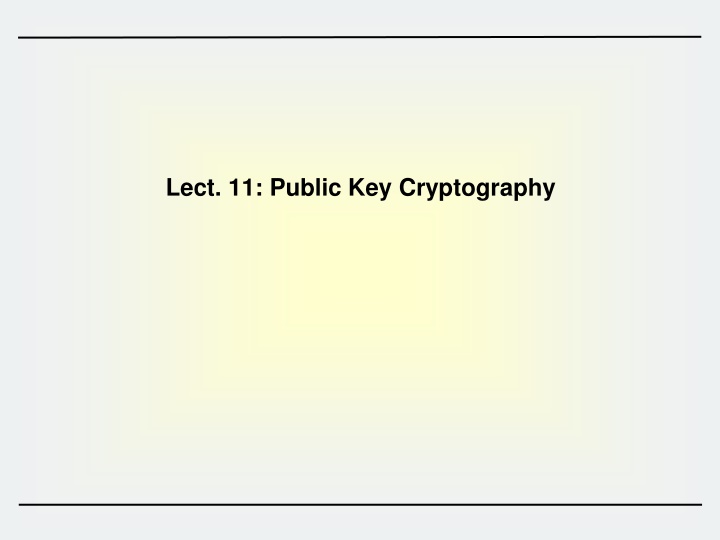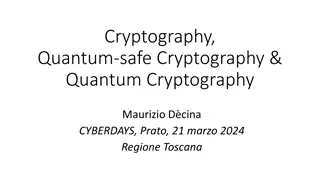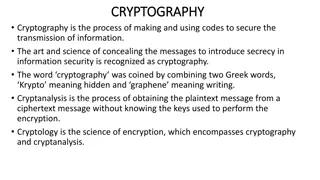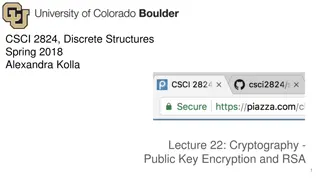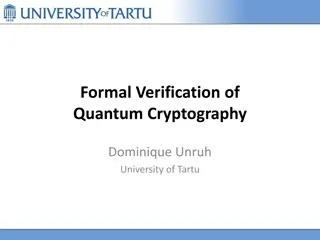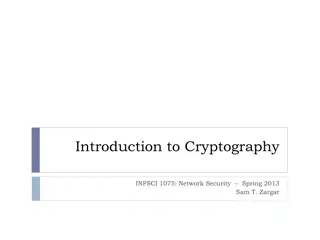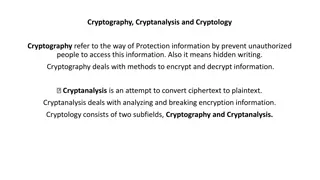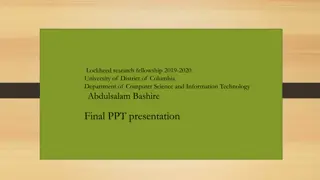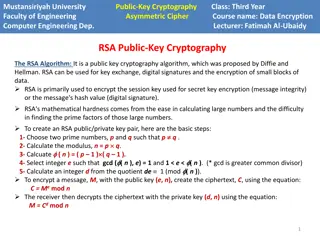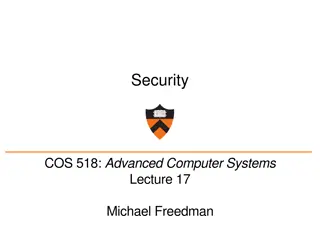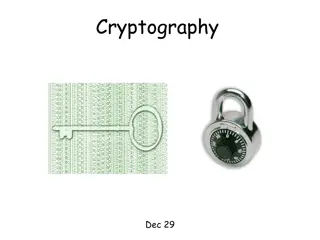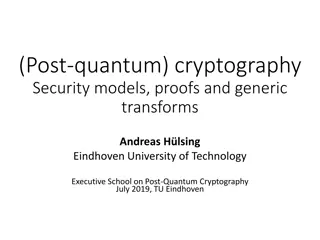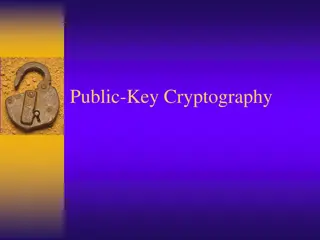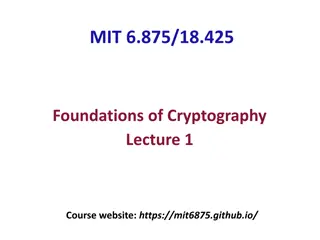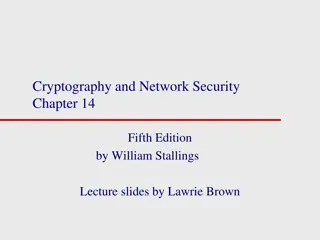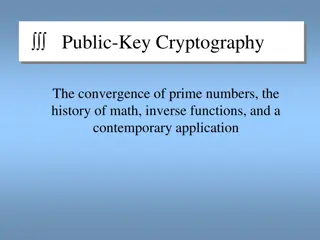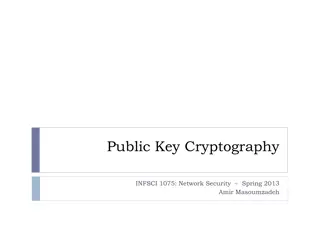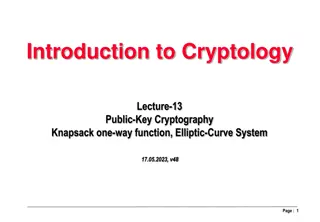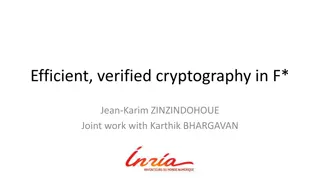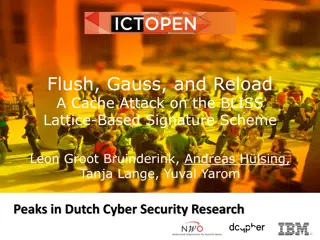Lect. 11: Public Key Cryptography
Public Key Cryptography introduces the concept of using mathematical relationships between keys to enhance security in digital communications. The system involves keeping private keys secure while publishing public keys for encryption and digital signatures. It addresses the key distribution problem in symmetric encryption and revolutionizes secure communication with asymmetric encryption methods like RSA, ElGamal, and more.
Download Presentation

Please find below an Image/Link to download the presentation.
The content on the website is provided AS IS for your information and personal use only. It may not be sold, licensed, or shared on other websites without obtaining consent from the author.If you encounter any issues during the download, it is possible that the publisher has removed the file from their server.
You are allowed to download the files provided on this website for personal or commercial use, subject to the condition that they are used lawfully. All files are the property of their respective owners.
The content on the website is provided AS IS for your information and personal use only. It may not be sold, licensed, or shared on other websites without obtaining consent from the author.
E N D
Presentation Transcript
Contents 1. 2. Introduction to PKC Hard problems IFP DLP Public Key Encryptions RSA ElGamal Digital Signatures DSA, KCDSA Schnorr Key Exchange Elliptic Curve Cryptosystems 3. 4. 5. 6. 2
Key Distribution Problem of Symmetric Key Crypto In symmetric key cryptosystems Over complete graph with n nodes, nC2= n(n-1)/2 pairs secret keys are required. (Example) n=100, 99 x 50 = 4,950 keys are required Problem: Managing large number of keys and keeping them in a secure manner is difficult a Secret keys are required between (a,b), (a,c), (a,d), (a,e), (b,c), (b,d), (b,e), (c,d), (c,e), (d,e) e b c d 4
Public Key Cryptography - Concept Using a pair of keys which have special mathematical relation. Each user needs to keep securely only his private key. All public keys of users are published. In Encryption Anyone can lock (using the public key) Only the receiver can unlock (using the private key) In Digital Signature Only the signer can sign (using the private key) Anyone can verify (using the public key) 5
Public Key Cryptography Concept (1/3) One-way functions Given x, easy to compute y=f(x). Difficult to compute x=f-1(y) for given y. easy x, y = f(x) domain parameters f domain parameters hard Ex) f(x)= 7x21+ 3x3+ 13x2+1 mod (215-1) 6
Public Key Cryptography Concept (2/3) Trapdoor one-way functions Given x, easy to compute f(x) Given y, difficult to compute f-1(y) in general Easy to compute f-1(y) for given y to only who knows certain information (which we call trapdoor information) easy x, y = f(x) domain parameters f domain parameters hard trapdoor info. public key private key But, easy if trapdoor info. is given. 7
Public Key Cryptography Concept (3/3) Concept invented by Diffie and Hellman in 1976, New directions in Cryptography , IEEE Tr. on IT. ,Vol. 22, pp. 644-654, Nov., 1976. Overcome the problem of secret key sharing in symmetric cryptosystems Two keys used: public key & private key Also known as two-key or asymmetric cryptography Based on (trapdoor) one-way function easy x, y = f(x) domain parameters f domain parameters hard trapdoor info. public key private key But, easy if trapdoor info. is given. 8
Public Key Cryptography Keys A pair of (Public Key, Private Key) for each user Public keys must be publicly & reliably available Encryption schemes Encrypt with peer s Public Key; Decrypt with its own Private Key RSA, ElGamal Digital signature schemes Sign with its own Private Key; verify with peer s Public Key RSA, DSA, KCDSA, ECDSA, EC-KCDSA Key exchange schemes Key transport or key agreement for secret-key crypto. RSA; DH(Diffie-Hellman), ECDH All problems clear? New Problem : How to get the right peer s Public Key? Public key infrastructure (PKI) required Certificate is used to authenticate public key 9
Public Key Cryptosystems Public key cryptography is based on hard problems. Encryption schemes RSA: based on IFP ElGamal: based on DLP Signature schemes Signature schemes with message recovery: RSA Signature with appendix: ElGamal, DSA, KCDSA Key exchange schemes Key transport: a trusted entity TA generates and distributes key Key agreement: Diffie-Hellman key agreement. Both entity take part in the key agreement process to have an agreed key 10
Public Key Encryption vs. Digital Signature Alice Bob Ciphertext D E Plaintext M Plaintext M C Alice s Public Key Alice s Private Key Authentic channel Alice Bob Message + Signature V S Yes / No Plaintext M M + s Bob s public Key Bob s private Key Authentic channel 11
Public Key Cryptosystems History RSA scheme (1978) R.L.Rivest, A.Shamir, L.Adleman, A Method for Obtaining Digital Signatures and Public Key Cryptosystems ,CACM, Vol.21, No.2, pp.120-126,Feb,1978 McEliece scheme (1978) Rabin scheme (1979) Knapsack scheme (1979-): Merkle-Hellman, Chor-Rivest, etc. ElGamal scheme (1985) Elliptic Curve Cryptosystem (1985): Koblitz, Miller Non-Abelian group Cryptography (2000): Braid group 12
Symmetric key vs. Asymmetric Key Crypto O : Good X : Bad Symmetric Asymmetric Enc. Key Dec. key Enc. key = Dec. key Key relation Secret Public, {Private} Enc. Key Secret Private, {Public} Dec. key Classified Open Open Algorithm SKIPJACK AES RSA Example Required (X) Not required (O) Key Distribution Many (X) Small (O) Number of key Fast(O) Slow(X) Performance 13
